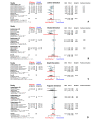Accuracy of Augmented Reality-Assisted Navigation in Dental Implant Surgery: Systematic Review and Meta-analysis
- PMID: 36598798
- PMCID: PMC9856431
- DOI: 10.2196/42040
Accuracy of Augmented Reality-Assisted Navigation in Dental Implant Surgery: Systematic Review and Meta-analysis
Abstract
Background: The novel concept of immersive 3D augmented reality (AR) surgical navigation has recently been introduced in the medical field. This method allows surgeons to directly focus on the surgical objective without having to look at a separate monitor. In the dental field, the recently developed AR-assisted dental implant navigation system (AR navigation), which uses innovative image technology to directly visualize and track a presurgical plan over an actual surgical site, has attracted great interest.
Objective: This study is the first systematic review and meta-analysis study that aimed to assess the accuracy of dental implants placed by AR navigation and compare it with that of the widely used implant placement methods, including the freehand method (FH), template-based static guidance (TG), and conventional navigation (CN).
Methods: Individual search strategies were used in PubMed (MEDLINE), Scopus, ScienceDirect, Cochrane Library, and Google Scholar to search for articles published until March 21, 2022. This study was performed in accordance with the PRISMA (Preferred Reporting Items for Systematic Reviews and Meta-Analyses) guidelines and registered in the International Prospective Register of Systematic Reviews (PROSPERO) database. Peer-reviewed journal articles evaluating the positional deviations of dental implants placed using AR-assisted implant navigation systems were included. Cohen d statistical power analysis was used to investigate the effect size estimate and CIs of standardized mean differences (SMDs) between data sets.
Results: Among the 425 articles retrieved, 15 articles were considered eligible for narrative review, 8 articles were considered for single-arm meta-analysis, and 4 were included in a 2-arm meta-analysis. The mean lateral, global, depth, and angular deviations of the dental implant placed using AR navigation were 0.90 (95% CI 0.78-1.02) mm, 1.18 (95% CI 0.95-1.41) mm, 0.78 (95% CI 0.48-1.08) mm, and 3.96° (95% CI 3.45°-4.48°), respectively. The accuracy of AR navigation was significantly higher than that of the FH method (SMD=-1.01; 95% CI -1.47 to -0.55; P<.001) and CN method (SMD=-0.46; 95% CI -0.64 to -0.29; P<.001). However, the accuracies of the AR navigation and TG methods were similar (SMD=0.06; 95% CI -0.62 to 0.74; P=.73).
Conclusions: The positional deviations of AR-navigated implant placements were within the safety zone, suggesting clinically acceptable accuracy of the AR navigation method. Moreover, the accuracy of AR implant navigation was comparable with that of the highly recommended dental implant-guided surgery method, TG, and superior to that of the conventional FH and CN methods. This review highlights the possibility of using AR navigation as an effective and accurate immersive surgical guide for dental implant placement.
Keywords: accuracy; augmented reality; computer-guided surgery; dental implants; meta-analysis; systematic review.
©Hang-Nga Mai, Van Viet Dam, Du-Hyeong Lee. Originally published in the Journal of Medical Internet Research (https://www.jmir.org), 04.01.2023.
Conflict of interest statement
Conflicts of Interest: None declared.
Figures









References
-
- Younes F, Cosyn J, De Bruyckere T, Cleymaet R, Bouckaert E, Eghbali A. A randomized controlled study on the accuracy of free-handed, pilot-drill guided and fully guided implant surgery in partially edentulous patients. J Clin Periodontol. 2018 Jun;45(6):721–32. doi: 10.1111/jcpe.12897. - DOI - PubMed
Publication types
MeSH terms
Substances
LinkOut - more resources
Full Text Sources
Research Materials
Miscellaneous

